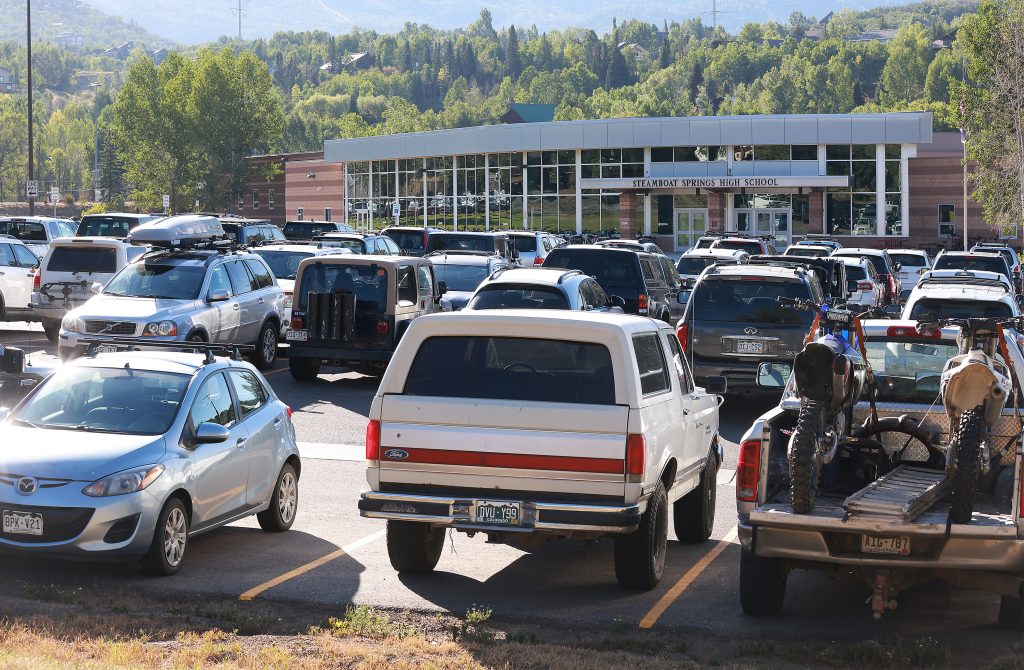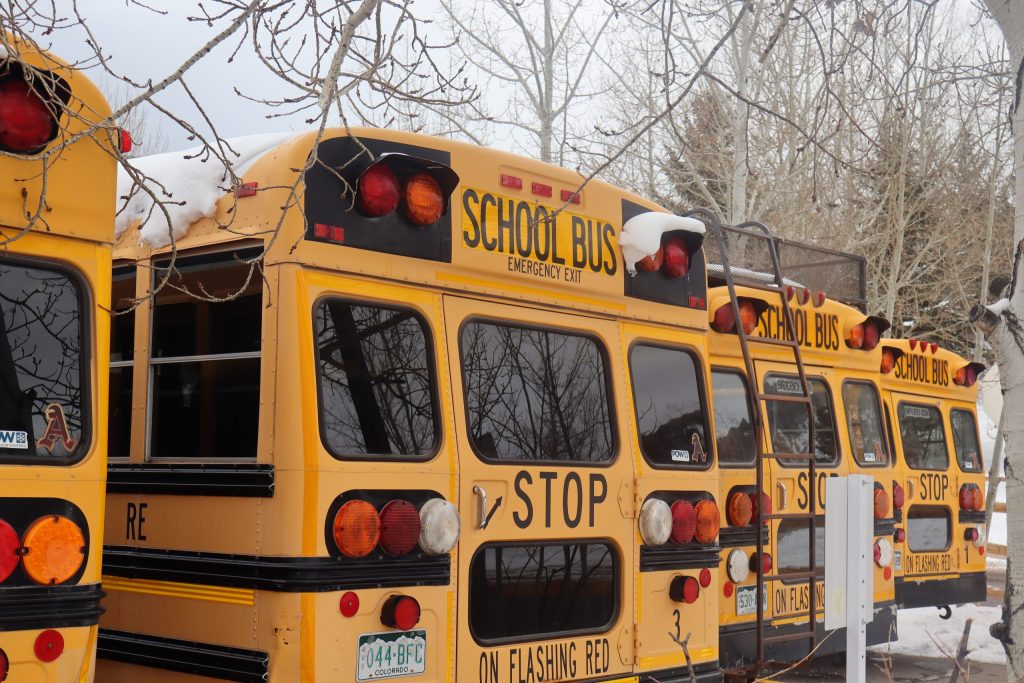Colorado schools are working to halve chronic absenteeism rates by 2027 — here’s what’s working

John F. Russell/Steamboat Pilot & Today
Colorado schools are close to completing their second month of classes — and already some on the Western Slope are seeing signs of improvement from last year’s heightened chronic absenteeism rates. Between old and new barriers to attendance, however, districts and state departments are juggling different solutions to getting children back into classrooms.
Last school year, Colorado’s average chronic absenteeism rate rose to 28.4%, adding 3,500 more chronically absent students compared to the year prior.
The increase in statewide averages for chronic absenteeism and declines in daily attendance mark a slight regression on the progress several districts had made following the COVID-19 pandemic, which brought Colorado’s chronic absenteeism rate to a record 35.5% in 2021-22.
A student’s absenteeism is considered chronic when they miss 10% or more of the school days in one academic year — or 16-18 days depending on the school. In 2024, the Colorado Department of Education established a goal to reduce K-12 absenteeism by 50% from its pandemic high by the 2026-27 school year.
Despite the statewide drops in attendance in 2024-25, 59% of school districts and BOCES in Colorado saw declines in chronic absenteeism, meaning the state could still be on track to meeting its goal.
Alyssa Pearson, special project advisor with the Colorado Department of Education, said that roughly half of Colorado districts are on track to reduce their chronic absenteeism rates by 50% within the five-year campaign. Some districts have already kicked off the school year with mostly positive attendance trends.
The Eagle County School District was one of the 105 districts to see improvements in its chronic absenteeism rates between the 2023-24 and 2024-25 academic years. Melisa Rewold-Thuon, assistant superintendent of student support services, said that 21.8% of students are chronically absent so far this school year as of Oct. 9, down by over 14 percentage points compared to this time last year.
Summit School District also saw improved absenteeism rates last year. Summit Middle School currently sits at a 21.75% absenteeism rate since the start of the school year in August, according to assistant principal Erin Dillon. If that rate lasts through November, she said, it could point to a broader improvement in attendance.
“I would say, if I were to guess, that we are really headed in a positive direction,” Dillon said. “(We) are continuing the same trend that we have for the last couple years, of reducing it. It feels really good.”
School attendance is especially important during the fall because of “head count day” on Oct. 1, which is when public schools finalize official enrollment numbers used to determine state funding.
Why are schools still struggling with chronic absenteeism?
While several district-led efforts have contributed to improving attendance in Western Slope schools, some external challenges keeping students home are harder to address.
Danielle Ongart, assistant commissioner with the Student Pathways & Engagement Unit, said during Wednesday’s Colorado State Board of Education meeting that despite the recovery in attendance schools have achieved since the pandemic, several misconceptions remain surrounding the importance of in-person learning and how to handle sickness during the school year.
While addressing these misconceptions, some districts are seeing it as an opportunity to revisit expectations for attendance and in-person learning.
“This is good and bad. This is bad because attendance got a lot worse but it has created a focus on it,” said Johann Liljengren, director of Dropout Prevention and Student Reengagement at the Colorado Department of Education. He added that 14 other states across the country have also committed to reducing their statewide chronic absenteeism rate by 50%.
“We do have a cohort in some way of other state agencies that are learning in this space as well. … We’ve learned a lot from those other states,” Liljengren said.
Several barriers for student attendance are completely independent of the shift in learning that occurred during 2020, such as challenges in moving homes or transportation — an especially significant barrier in more remote districts.
“Our transportation department has worked really hard over the last couple years to accommodate families and make sure everyone has a school bus available to them. But we’re so spread out that it is really hard sometimes,” Dillon said. “Kids out of the district … don’t have access to the bus, so traveling that distance across a pass when the weather’s bad can be hard.”
Ongart said students are also more likely to fall behind on their attendance when they don’t feel connected to other students, staff or content taught at the school. Others might avoid school if they feel anxiety surrounding their relationship with their peers or if they fear for their safety.
“Our dips in attendance, or where we’ve seen poor attendance, has been on specific days where ICE has been in our community,” Dillon said. “That is just something that is completely out of our locus of control.”
Summit schools saw a 35% drop in attendance lasting roughly two weeks following rumors of ICE presence in the county during the week of Sept. 8 and two U.S. Immigration and Customs Enforcement operations on Sept. 16, according to previous reporting by the Summit Daily.
“We continue to hear from our families who are fearful of ice … that school feels like a safe place,” she added. “They are not fearful of their child being at school, and kids will say the same thing, ‘I feel safe at school.’ It’s the transition to and from school.”
Not all school districts on the Western Slope have shared this challenge so far into the school year. Jennifer Baugh, superintendent of the Garfield County School District, said the district has not observed changes to attendance driven by ICE raids as of Sept. 26 — though parents may or may not share the reason for a student’s absence.
“I’m really worried that we’ll see (this rate) go up because of the impact of the ICE raids, but I guess we’ll see that when we see the next data,” Colorado State Board of Education member Kathy Gebhardt, D-Boulder, said during the meeting. “There’s not much we can do about that, it’s just something to be sensitive to because what I’m hearing anecdotally is that attendance numbers are going way down, so I think it’ll impact us on our October count and we’ll see a hit on chronic absenteeism.”
Another barrier to attendance that is perhaps more specific to mountain resort towns are absences for recreational activities and other vacations, according to Dillon.
“We’ve really just been asking, even pleading with our families, to do those things on the time off,” Dillon said. “Because the truth is, kids get 39 days off during the school year from when August starts to when school ends in June. … You might not be worried about your kid academically, you may be confident that they can keep up with the work, but then their voice is missing from our classroom.”

What’s working — and what isn’t
During the 2024-25 school year, the Colorado Department of Education implemented several strategies to improve the state’s absenteeism rate, including producing data tools for districts to better understand their attendance trends and launching an attendance awareness campaign.
Other efforts focused on the well-being of students, such as providing free meals to students through the Healthy School Meals for All program approved by voters in 2022.
“These meals ensure that hunger is not a barrier to learning, and students can continue to engage,” Ongart said. “We have also heard, anecdotally, that Healthy School Meals for All has been a draw for students to come to school every day.”
To expand on their efforts in 2025-26, Ongart said the department plans to target resources for staff retention, such as grants and training, in high-need roles like specialized service providers. The education department is also planning a series of “community learning sessions” with students to better-understand what drives attendance and engagement.
Some of the funding for these trainings and attendance efforts comes from what the Colorado legislature designates to the department’s Dropout Prevention and Student Re-Engagement Office, though Ongart said “more resources would always be helpful” to reach more districts.
Board Chair Rebecca McClellan suggested that younger students may already be in the process of unlearning some of the “bad habits” related to lower attendance, since many didn’t experience the transition from in-person learning to remote learning during the pandemic. Attendance data from the 2024-25 school year shows that chronic absenteeism decreased in kindergarten, first and second grades, while increasing in the higher grades.
“When we had to pivot to online (school), it’s great that we’re able to do that — and for students who really need that, it’s great that it’s there — but I think one of the things we also heard echoed in our Canyon City visit was that … it doesn’t work for all students as well as in-person learning with professional educators,” McClellan said. “One of my worries is that (relying on online options) creates an opportunity for people to try to see if they can tick the box and get requirements done in a way that might be easier.”
Ongart said the department’s School Health Services team is also working with an informal advisory board of school nurses and members of the state department of public health to create more specific guidance for what illness absences should look like, such as how many days a student should be absent if they get measles.
“We have a culture shift in illness. When I was growing up, you went to school if you were sick or not,” Board Member Kathy Plomer said. “Now, it’s more like, ‘Please keep your child home, we do not want things spreading around.’ We have different ways of looking at whether you should send your child to school (if) they’re ill.”
Local school districts have also done internal work to address the role of student health in chronic absenteeism.
“We work with families and students on, ‘What are healthy sleep routines? What are healthy nutritional habits?'” Dillon said. “We’re kind of moving further and further away from this, but I think there was a lot of trepidation around families sending kids to school at all with any kind of cold after a pandemic. I think we’ve moved away from that. We’ve tried to really message ‘how sick is too sick’ to our families.”
Rewold-Thuon said some of Eagle schools have gone above and beyond the district initiatives to form their own attendance committees and incentive systems. Battle Mountain High School’s attendance committee succeeded in reducing their chronic absenteeism from 27% to 17% through their in-school model.

Support Local Journalism

Support Local Journalism
Readers around Steamboat and Routt County make the Steamboat Pilot & Today’s work possible. Your financial contribution supports our efforts to deliver quality, locally relevant journalism.
Now more than ever, your support is critical to help us keep our community informed about the evolving coronavirus pandemic and the impact it is having locally. Every contribution, however large or small, will make a difference.
Each donation will be used exclusively for the development and creation of increased news coverage.










